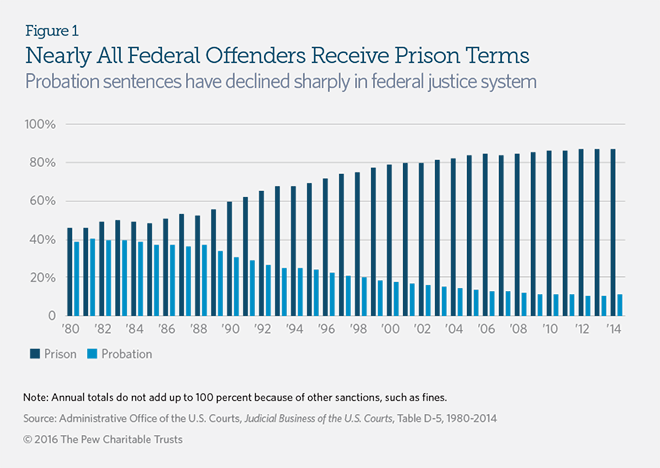More Prison, Less Probation for Federal Offenders
Policy changes have favored incarceration over community supervision
Overview
Over the past three decades, imprisonment has become the dominant sanction in the federal criminal justice system. Nine in 10 federal offenders received prison sentences in 2014, up from less than half in 1980, as the use of probation declined steadily.1 (See Figure 1.) Federal courts sentenced 2,300 fewer offenders to probation in 2014 than in 1980, even though their caseload nearly tripled during that span.2
Changes in the kinds of offenses and offenders prosecuted in federal court may have contributed to the shift toward prison and away from probation.3 But sentencing policies established during the 1980s and 1990s also played an important role by mandating prison time for many offenses for which probation had routinely been ordered in the past.4

Sentencing laws and guidelines reduced the use of probation
Congress increased imprisonment and decreased the use of probation in several ways. During the 1980s and 1990s, for example, lawmakers enacted dozens of laws prohibiting probation and requiring prison terms for many common federal crimes, including drug trafficking and illegal firearms possession.5
In 1984, Congress created the U.S. Sentencing Commission, an independent agency within the judicial branch, and charged it with establishing guidelines that federal judges were required to follow during sentencing. The guidelines, which were intended to promote consistency in federal criminal penalties and took effect in November 1987, mandated imprisonment for a variety of offenses—including fraud, embezzlement, and tax evasion—for which probation was a routine sanction in the past.6
In a 2005 ruling, the U.S. Supreme Court deemed the guidelines “advisory,” but their effects remain evident: More than three-quarters of federal fraud offenders, for instance, received prison terms in 2014, compared with less than half in 1980.7
Endnotes
- Administrative Office of the U.S. Courts, Judicial Business of the U.S. Courts, Table D-5, 1980-2014, http://www.uscourts.gov/statisticsreports/analysis-reports/judicial-business-united-states-courts. Reports prior to 1997 are available in print only.
- Ibid.
- U.S. Sentencing Commission, Fifteen Years of Guidelines Sentencing (November 2004), Chapter 2, http://www.ussc.gov/sites/default/files/pdf/research-and-publications/research-projects-and-surveys/miscellaneous/15-year-study/chap2.pdf. Drug cases rose from 17 percent to 32 percent of the federal caseload from 1980 to 2014, while immigration cases increased from 7 percent to 28 percent. See Administrative Office of the U.S. Courts, Judicial Business of the U.S. Courts, Table D-5, 1980-2014.
- Ibid. See also: Bureau of Justice Statistics, Time Served in Prison by Federal Offenders, 1986-97 (June 1999), 1, http://www.bjs.gov/content/pub/pdf/tspfo97.pdf.
- Charles Doyle, Federal Mandatory Minimum Sentencing Statutes (Washington: Congressional Research Service, 2013), https://www.fas.org/sgp/crs/misc/RL32040.pdf.
- U.S. Sentencing Commission, Fifteen Years of Guidelines Sentencing, Chapter 2.
- Administrative Office of the U.S. Courts, Judicial Business of the U.S. Courts, Table D-5, 1980-2014. Federal courts sentenced approximately 10,000 fraud offenders in 2014 and roughly 4,500 in 1980.






